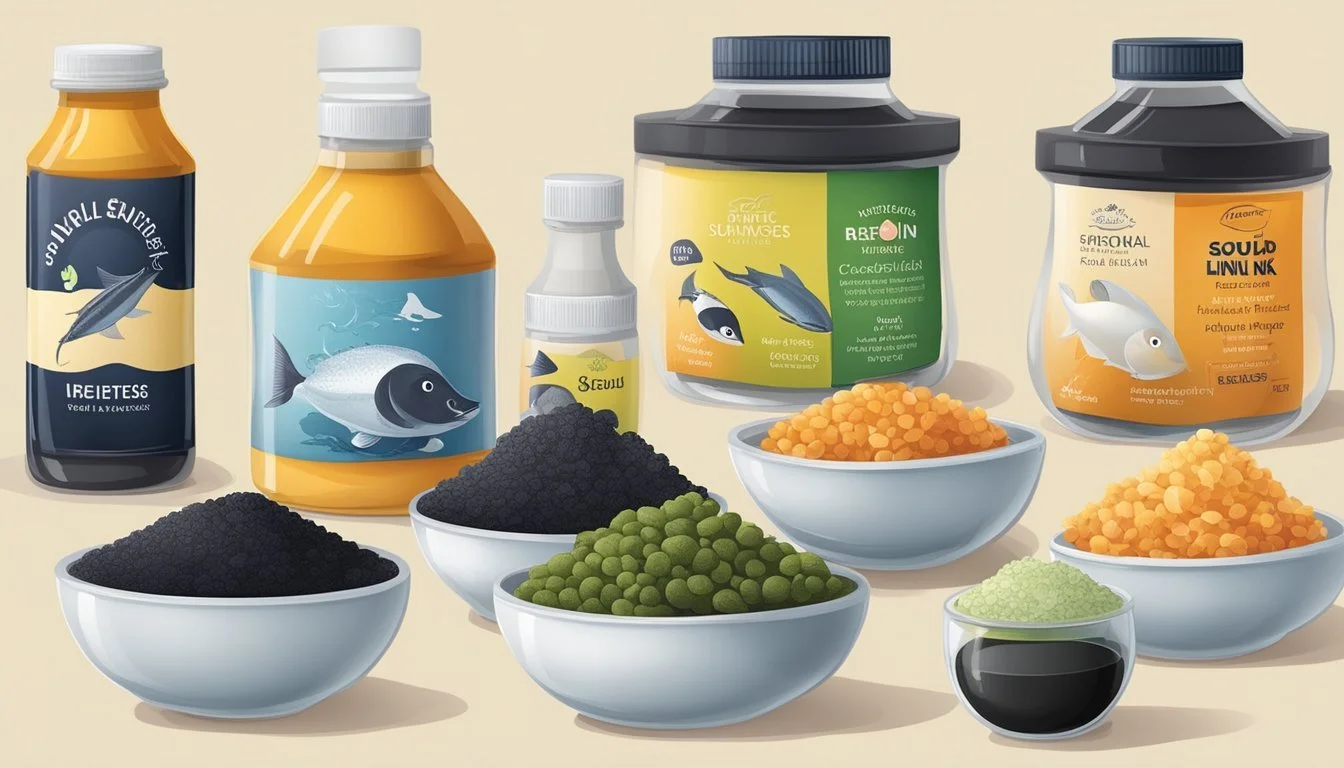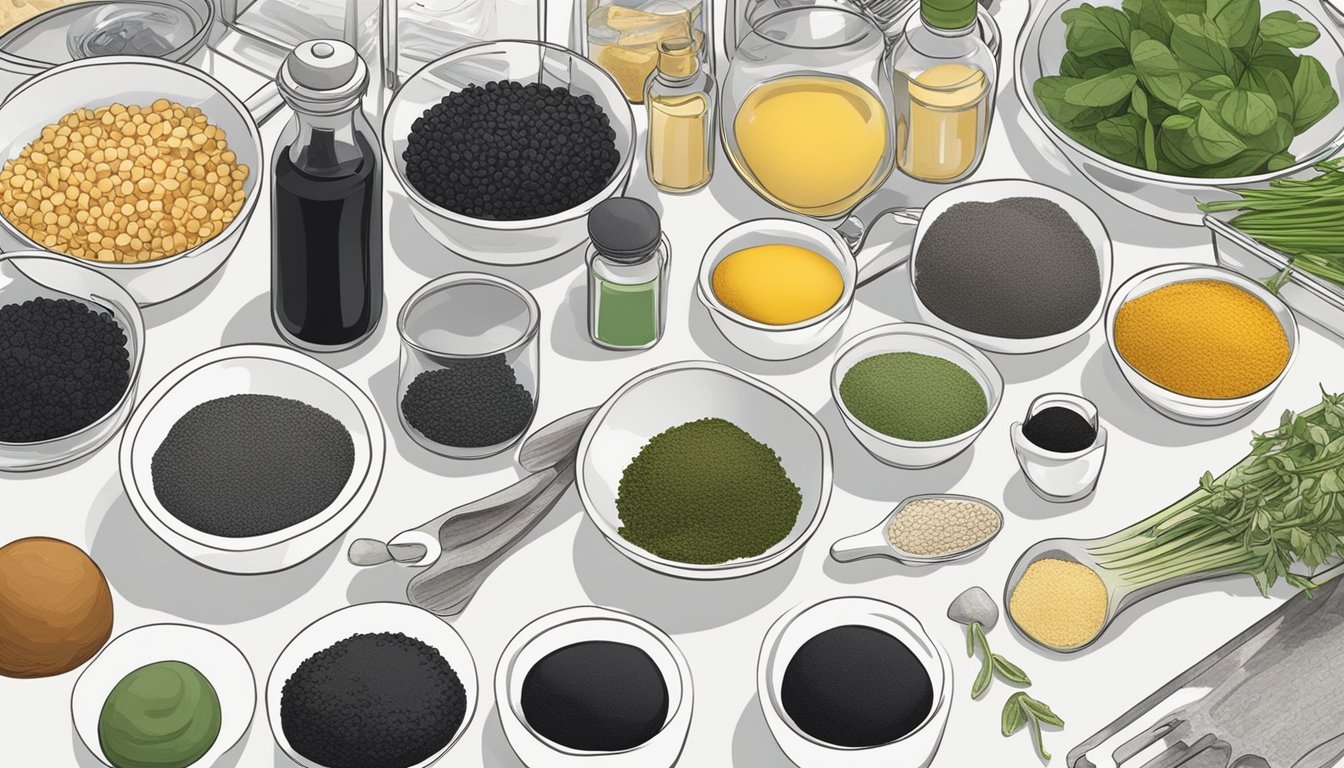Squid Ink Substitutes
Best Alternatives for Cooking and Baking
Squid ink, with its rich umami flavor and striking black color, is a beloved ingredient in various culinary dishes. From the classic Italian pasta dishes to gourmet seafood recipes, squid ink offers a flavor depth that’s hard to replicate. Yet, due to allergies, dietary preferences, or availability issues, finding suitable substitutes has become increasingly important for home chefs and restaurant kitchens alike.
When seeking alternatives for squid ink, a few options stand out for replicating its texture and appearance. Activated charcoal, for instance, can impart the dark hue desired in dishes like pasta or rice, without altering the taste significantly. Additionally, ingredients such as black beans can be ground into a flour to create a vegan-friendly pasta that mimics the look of traditional squid ink varieties.
Another interesting option is tofu or seitan, which can be used to replicate the chewy texture often associated with squid in dishes. These soy and wheat-based substitutes not only cater to vegetarians and vegans but also help maintain the integrity of the dish by resembling squid rings or pieces closely. These substitutes ensure that the culinary adventure continues, offering diverse options without compromising on flavor or aesthetic appeal.
Understanding Squid Ink
Squid ink is a unique culinary ingredient primarily used to add color and flavor to various dishes. It is harvested from marine creatures such as squids, cuttlefish, and sometimes octopuses and is known for its distinctive umami taste and potential health benefits.
Origin and Harvesting
Squid ink, also referred to as cephalopod ink, is a dark pigment secreted by squids and cuttlefish. This ink is part of their defense mechanism, enabling them to escape predators.
The harvesting process involves extracting the ink sac from freshly caught squids or cuttlefish. The sac is then carefully punctured, and the ink is collected. This delicate process ensures the ink retains its flavor and nutritional properties.
Culinary Importance
In culinary arts, squid ink is valued for its rich, briny flavor and ability to impart a striking black color to dishes. Predominantly used in Mediterranean and Japanese cuisines, it adds depth to various recipes including pasta, risotto, and seafood dishes.
The umami flavor from squid ink enhances the taste profiles of these dishes, making them more savory and robust. Its unique color also provides visual appeal, elevating the dining experience.
Health Benefits and Nutritional Value
Squid ink is not only a flavorful addition to dishes but also boasts several health benefits. It is low in calories and rich in essential nutrients such as vitamins, minerals, and antioxidants.
Key components include omega-3 fatty acids, vitamin B12, and selenium. These nutrients support cardiovascular health, boost the immune system, and provide anti-inflammatory properties. Additionally, the antioxidants in squid ink help combat free radicals, contributing to overall health and well-being.
By offering both nutritional value and a unique taste, squid ink makes for a versatile ingredient in various culinary applications.
Popular Squid Ink Applications
Squid ink is widely appreciated for its rich, intense flavor and unique coloring properties, finding versatile uses in both traditional and modern culinary dishes.
Traditional Dishes
Squid ink has been a staple in Mediterranean and Japanese cuisines for centuries. A classic example is squid ink pasta, where the ink is incorporated into the dough, giving the pasta a striking black color and a subtle briny taste. This dish is often paired with seafood like squid, mussels, and shrimp to enhance the marine flavors.
In Spanish cuisine, squid ink is central to Arroz Negro, a black rice dish simmered with squid or cuttlefish, garlic, onions, and seafood broth. The ink not only provides the dark hue but also enriches the taste with its savory, umami qualities. Italian seafood risotto also benefits from the addition of squid ink, adding depth and complexity to the dish.
Modern Cuisine Innovations
Contemporary chefs have pushed the boundaries of squid ink applications, incorporating it in innovative ways that highlight its dramatic aesthetic and unique flavor profile. Squid ink soup is a modern twist, combining the ink with broth, vegetables, and sometimes, shellfish, creating a visually captivating dish with a rich, umami-laden broth.
Another innovation is the use of squid ink in stews, where it adds depth to the stock, enhancing the flavors of the other ingredients without overwhelming them. Additionally, smaller applications like squid ink aioli or squid ink-infused sauces bring a gourmet touch to dishes, elevating the culinary experience with their bold appearance and taste.
Squid ink continues to inspire chefs, who blend traditional uses with modern techniques to create dishes that are not only delicious but visually striking.
Why Seek Squid Ink Substitutes?
Seeking squid ink substitutes can be driven by various reasons, including dietary restrictions and environmental concerns. These factors are important for those wishing to enjoy similar culinary experiences without compromising their values or health.
Dietary Restrictions and Allergies
People with dietary restrictions or allergies might need substitutes for squid ink. Those following vegetarian or vegan diets avoid animal products altogether, including cephalopods like squid.
Squid ink can also cause allergic reactions. Shellfish allergies are common and can trigger symptoms ranging from mild rashes to severe anaphylactic reactions. Individuals with these allergies often seek plant-based or artificial alternatives.
Additionally, some religions and cultures have strict dietary rules that prohibit consuming squid and its byproducts.
Tofu, seitan, and konjac serve as excellent substitutes, offering similar textures and flavors without the animal-based components. These alternatives cater to specific nutritional needs and restrictions while ensuring an enjoyable dining experience.
Environmental and Sustainability Concerns
Overfishing endangers marine ecosystems and the sustainability of marine life. Squid populations, like many other marine species, suffer from overexploitation. This poses significant environmental concerns.
Squid ink substitutes can reduce the environmental impact of overfishing. Beyond conserving species, making sustainable choices helps balance marine ecosystems.
Environmental advocates might prefer plant-based products to support a more sustainable food system. Alternatives such as konjac or algae-based products reduce dependence on marine resources.
Using these substitutes aligns with efforts to protect marine environments and promote biodiversity, ensuring future generations can also enjoy the ocean's bounty.
These substitutes not only address dietary concerns but also support broader efforts toward environmental preservation.
Plant-Based Squid Ink Alternatives
Plant-based squid ink substitutes offer a way to replicate the unique color and some textures of traditional squid ink while maintaining a vegan and vegetarian-friendly diet. These alternatives often focus on ingredients that offer similar visual appeal and health benefits.
Vegan-Friendly Substitutes
Activated charcoal can be used for a dramatic black color in dishes. Made from heating carbon-rich materials, it provides the rich pigmentation desired without any animal products. It should be used in moderation due to potential health concerns.
Algae and seaweed are excellent options. Certain types like nori or spirulina can be processed to simulate the taste and color of squid ink. They offer a seafood-like flavor while keeping dishes vegan.
King oyster mushrooms can be ground into a paste and combined with natural black dyes like charcoal or black sesame powder to create a rich, dark sauce suitable for pasta or risotto.
Health-Focused Ingredients
Pumpkin and squash can be integrated with black food coloring derived from natural sources to achieve a healthful, colorful substitute. These vegetables add fiber, vitamins, and antioxidants to the dish.
Tofu offers a versatile base for creating various textures needed in vegan seafood substitutes. When mixed with black sesame seeds or powdered black beans, it adds protein and creates a convincing alternative.
Konjac, a low-calorie root vegetable, boasts a gelatinous texture similar to squid when properly prepared. Blending konjac with plant-based black dyes like activated charcoal can produce a vegan-friendly, health-conscious squid ink substitute.
By using these ingredients, individuals can enjoy creative and nutritious alternatives to traditional squid ink while adhering to their dietary choices.
Other Seafood Substitutes
Seafood replacements offer a variety of options for those seeking alternatives to traditional squid. These substitutes range from other sea animals to specific fish and shellfish imitations that replicate the texture and flavor of squid.
Utilizing Other Sea Animals
Cuttlefish serves as a practical alternative due to its similar texture and flavor to squid. Both are cephalopods, providing a soft, chewy consistency when cooked. Cuttlefish has a mild, slightly sweet taste that can mimic squid in many recipes. Additionally, octopus can also be used; its texture is slightly firmer, but it offers a comparable culinary experience.
Tofu, though not an animal, often stands in for seafood in vegan dishes. When marinated and cooked correctly, firm tofu can emulate the texture of squid, though it lacks the intrinsic flavor.
Fish Alternatives
Certain fish can stand in for squid in various recipes. Monkfish has a firm texture and flavor profile that works well in dishes requiring longer cooking times. It can hold up in stews and curries, making it a strong substitute.
Swordfish and halibut are also suitable options. Swordfish has a dense, meaty texture, while halibut offers a milder taste and a flaky consistency. Both types of fish can absorb flavors well when marinated and are versatile enough for grilling, baking, or frying.
Shellfish Imitations
Shrimp and scallops are popular alternatives. Shrimp, when properly cooked, exhibits a firm and slightly sweet taste similar to squid. Scallops, particularly sea scallops, offer a tender, succulent meat and a naturally sweet flavor. They can be prepared in various ways, from pan-searing to grilling.
Additionally, konjac, derived from the root of the konjac plant, can serve as an imitation shellfish. Its gelatinous texture makes it suitable for replicating squid dishes, especially in vegan and vegetarian cuisine. Konjac is often used to make vegan seafood products due to its ability to absorb flavors and provide a similar mouthfeel.
Non-Seafood Flavor Enhancers
Achieving a rich, umami flavor without traditional seafood ingredients can be accomplished through various alternative enhancers. Key options include mushrooms, diverse sauces, and unconventional ingredients, each bringing unique and potent flavors to your culinary creations.
Mushrooms as Umami Donors
Mushrooms are excellent non-seafood umami donors. Varieties like shiitake, portobello, and cremini are particularly rich in umami compounds.
Dried mushrooms intensify flavors when rehydrated and can be added to broths or sauces. Soy sauce pairs well with mushrooms, amplifying the umami impact. Additionally, incorporating mushroom powder into dishes can provide a savory boost without altering texture.
Sauces and Condiments
Sauces and condiments can significantly enhance flavors. Soy sauce is a fundamental umami booster, while balsamic vinegar adds a sweet-tart complexity.
For a richer flavor profile, consider red sauces like bolognese or vodka sauce. These sauces are often enhanced with garlic and onions, contributing additional layers of flavor. Salt is essential for balancing these flavors and ensuring a well-rounded taste.
Unconventional Ingredients
Unconventional ingredients can also provide robust non-seafood flavors. Food-grade charcoal powder can add a subtle smokiness and depth to dishes.
Using fermented products like miso or tempeh can introduce complex flavors and an umami punch. Nutritional yeast is another excellent option, often used in vegan cooking to replicate the savory notes typically provided by cheese or meat.
Squid Ink Substitute Recipes
Creating squid ink substitutes can be both simple and convenient. There are straightforward homemade mixes and ready-made store-bought blends that offer accessible alternatives for those looking to mimic the unique flavor and color of squid ink in their dishes.
Homemade Mixes
Homemade mixes allow for customization in flavor and intensity. For a dark, inky color, use activated charcoal powder. Mix one teaspoon of the powder with two tablespoons of water to create a paste. This serves as an effective substitute in pasta or risotto recipes.
Black sesame paste is another viable option. Combine one tablespoon of ground black sesame seeds with enough water to form a thick paste. This yields a nutty flavor, suitable for various savory dishes and enhances the visual appeal with its dark hue.
Adding cuttlefish ink can also achieve the desired effect, provided it is available. It offers a similar taste and color profile, ensuring authenticity. Use one teaspoon per serving in your recipes. Each of these substitutes maintains the distinctiveness required for a variety of culinary creations.
Store-Bought Blends
Several store-bought blends come ready to use and simplify the process. Look for products containing activated charcoal or black sesame paste. These items are typically found in the spices or specialty food sections of grocery stores.
Cuttlefish ink jars usually reside in the seafood section and are easy to use, requiring no additional preparation. Follow the instructions on the packaging for accurate measurements.
There are also vegan squid ink substitutes, often made from plant-based ingredients like spirulina or charcoal extracts. These blends are especially suitable for those adhering to a vegan diet. They provide the same visual effects without compromising on flavor or texture, making them a versatile choice for various recipes.
Considerations for Choosing Substitutes
Selecting the appropriate squid ink substitute requires evaluating several factors such as flavor profile, texture, nutritional content, and market availability. This ensures that the chosen alternative effectively replicates the properties of squid ink in culinary applications.
Flavor Profile and Texture Matching
Matching the flavor profile and texture of squid ink is crucial. Squid ink has a unique briny taste and a thick, glossy texture that adds depth to dishes. Charcoal powder or black sesame paste can replicate the dark color but lack the briny flavor. For a closer match, consider seaweed-based alternatives like nori or kombu, which offer a marine flavor profile. Cuttlefish ink can be the best match, as it shares a similar taste and texture but might be harder to find in non-coastal areas.
Nutritional Concerns
When selecting a substitute, considering the nutritional aspects is essential. Squid ink contains antioxidants and essential minerals like iron. Vegan alternatives like spirulina or chlorella powder are rich in nutrients and offer health benefits, including high protein content and vital vitamins. Unlike cuttlefish ink, these plant-based options cater to dietary restrictions, offering similar nutritional value without compromising on health benefits. Activated charcoal, commonly used for coloring, lacks nutritional value and should be consumed in moderation, particularly for those seeking health benefits.
Availability and Price
Availability and price are practical considerations. Squid ink can be expensive and may not be readily available in all regions. Alternatives like black food coloring are easily accessible and economical. Cuttlefish ink might be more accessible in seafood markets but possibly at a higher cost. Plant-based options such as spirulina and black sesame paste provide more cost-effective and readily available choices. They are also versatile in various culinary applications, ensuring that budget constraints or local availability do not hinder culinary creativity.
Choosing the right substitute involves balancing these considerations to achieve a result that satisfies culinary needs and dietary preferences.
Incorporating Substitutes into Diets
Adapting squid ink substitutes into various diets requires knowledge of specific dietary needs and preferences. This guide covers key considerations for pescatarian, vegan, vegetarian, and gluten-free diets.
Pescatarian Adaptations
Pescatarians, who include fish and seafood in their diet but avoid other meats, have versatile options. They can substitute squid ink with alternatives like black sesame paste or cuttlefish ink, which maintains the distinct flavor and color of traditional squid ink dishes without straying from seafood.
Black sesame paste offers a rich, nutty flavor. Cuttlefish ink can be used in risottos and pastas, providing the classic dark hue. These alternatives ensure variety while staying true to seafood-based dishes.
Vegan and Vegetarian Integration
Vegan and vegetarian diets exclude all animal products and rely on plant-based substitutes. Activated charcoal can be used to replicate the black color of squid ink without animal derivatives. Another option is black bean sauce, which adds depth and color to dishes.
Vegan squid ink pasta can be made using activated charcoal combined with flour. Adding tofu, seitan, or konjac provides texture similar to seafood. These substitutions allow vegans and vegetarians to enjoy traditionally seafood-based recipes transformed to fit their dietary needs.
Gluten-Free Considerations
Those on a gluten-free diet must avoid wheat-based products. When incorporating squid ink substitutes, they can opt for gluten-free pasta and other products. Activated charcoal and black bean paste remain excellent choices for adding the desired black color without introducing gluten.
For added texture, agar agar can be used as a plant-based thickener. It provides a gelatinous feel similar to squid while being gluten-free. Ensuring all ingredients used are certified gluten-free is crucial for maintaining dietary restrictions and avoiding adverse reactions. These adaptations cater to the needs of a diverse, gluten-free audience.
Functional and Culinary Analysis
Understanding the functional properties and culinary applications of squid ink and its substitutes is vital. These aspects help chefs and food enthusiasts make informed decisions on using umami-rich ingredients in their dishes.
Molecular Composition and Umami
Squid ink is a unique source of umami flavor due to compounds like glutamate and certain amino acids.
This composition enhances the taste profile of various dishes, deepening their flavor complexity. Such properties make squid ink and its substitutes valuable in creating savory and unforgettable meals.
In terms of nutritional content, squid ink is rich in proteins, minerals, and antioxidants. These elements contribute not only to taste but also to the nutritional value of dishes. The functional benefits of squid ink extend to color and texture, providing a black hue and thickness to recipes.
Culinary Technique Adaptations
Adapting squid ink substitutes into culinary practices involves exploring cooking techniques that maintain or improve the dish's flavor and appearance.
Common squid ink recipes include risotto nero, pasta, and seafood dishes. Substitutes like plant-based inks or dark vegetable purées can mimic the color and some aspects of the flavor. Ink formulations from sources like algae can also be employed.
Chefs often incorporate substitutes by adjusting seasoning and cooking times to balance out the distinct sea-infused taste and umami characteristic of traditional squid ink. This attention to detail ensures the integrity and authenticity of the dish's flavor profile are preserved, even when using alternative ingredients.











